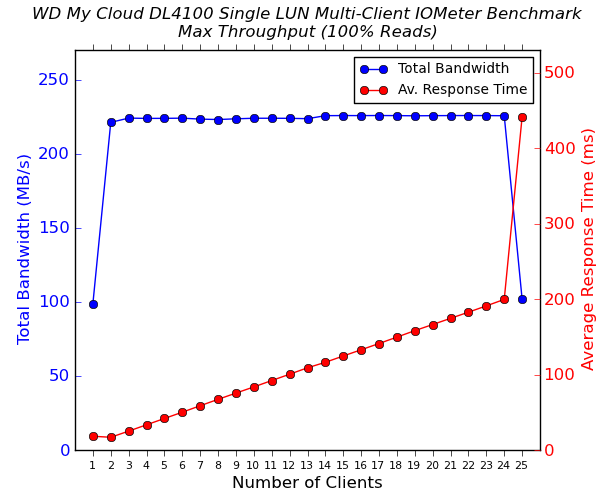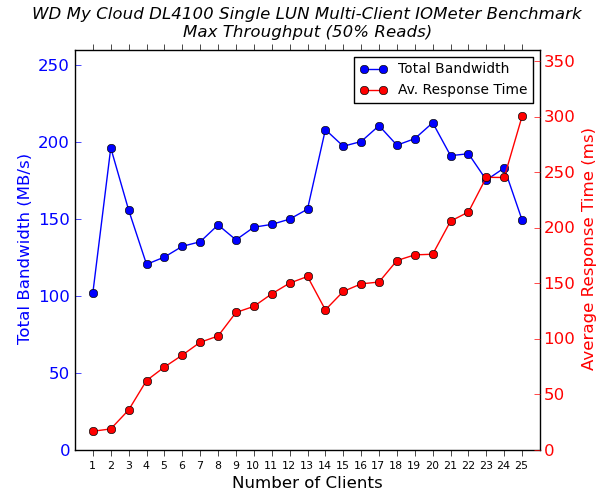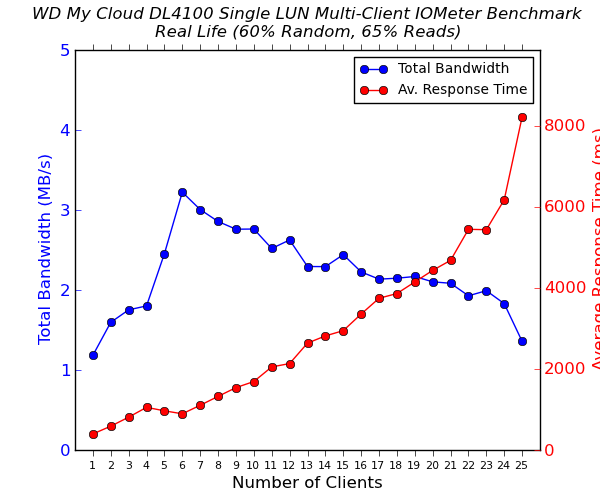Western Digital My Cloud DL4100 Business NAS Review
by Ganesh T S on March 4, 2015 5:30 AM EST- Posted in
- NAS
- Storage
- Western Digital
- Enterprise
Multi-Client iSCSI Evaluation
As virtualization becomes more and more popular even in home / power user settings, the importance of the iSCSI feature set of any COTS NAS can't be overstated. Starting with our ioSafe 1513+ review, we have started devoting a separate section (in the reviews of NAS units targeting SMBs and SMEs) to the evaluation of iSCSI performance. NAS vendors have multiple options when it comes to implementing iSCSI LUNs. By far, the most common and simplest method is in the form of regular files. Western Digital adopts that method too. WD also allows multiple initiators to connect to a single iSCSI target.
We evaluated the performance of the WD My Cloud DL4100 with file-based LUNs. In the first case, we configured a single LUN and had multiple initiators from different machines connect to it. In the second case, we created one LUN/target for each initiator to connect to. The standard IOMeter benchmarks that we used for multi-client CIFS evaluation were utilized for iSCSI evaluation also. The main difference to note is that the CIFS evaluation was performed on a mounted network share, while the iSCSI evaluation was done on a 'clean physical disk' (from the viewpoint of the virtual machine).
Performance Numbers
The four IOMeter traces were run on the physical disk manifested by mapping the iSCSI target on each VM. The benchmarking started with one VM accessing the NAS. The number of VMs simultaneously playing out the trace was incremented one by one till we had all 25 VMs in the fray. Detailed listings of the IOMeter benchmark numbers (including IOPS and maximum response times) for each configuration are linked below:
- WD My Cloud DL4100 - 4 HDDs / RAID-5 / 2x 1G - Single LUN (Regular File)
- WD My Cloud DL4100 - 4 HDDs / RAID-5 / 2x 1G - LUNs (Regular Files)




The performance issues we encountered in the single-client iSCSI benchmarks are evident here also. The other 4-bay NAS units we have put through these tests (the Seagate NAS Pro 4-bay as well as the Synology DS415+) exhibit better numbers as well as consistency compared to the WD My Cloud DL4100.
Towards the end of the iSCSI testing process, we ran a script on the clients' side to disconnect the iSCSI targets one by one, while refreshing the My Cloud DL4100's web UI's iSCSI page at the same time. During this process, the unit froze up completely - the web UI wasn't reachable, the LCD navigation froze and a SSH connection was refused - there was no way out but to yank out the power and restart the unit. Unfortunately, the logs reported only a power failure and this was not a repeatable issue. In addition to general performance improvements, it appears that the My Cloud OS could do with stability QA also.










27 Comments
View All Comments
Spoogie - Wednesday, March 4, 2015 - link
People aren't buying into it. Get over it.pbrutsche - Wednesday, March 4, 2015 - link
The fact that IT pros haven't adopted ZFS is not related to the RAID5/RAID6 issue; there are other reasons for that.I am an IT pro and I GUARANTEE that the issue with a URE (unrecoverable read event) during a RAID rebuild with large capacity drives is a VERY, VERY real concern that EVERYONE - EMC, Dell (MD3k series and EqualLogic), IBM, NetApp, Nimble, etc, etc - talks about, especially as the drives in your array get larger and larger.
You need to ask Seagate, QNAP and Synology engineers why they don't use ZFS, but I can hazard a guess it comes down to money: the memory requirements to effectively run ZFS is much higher than a more traditional EXT3/EXT4-on-MD setup - the more the better, but 1GB or 2GB isn't going to cut it, and putting more memory in the NAS costs more money (the effective minimum for ZFS is 4GB). Since they have a HUGE investment in a Linux-based architecture switching the OS their appliance runs makes even less sense (my limited experience with ZFS on Linux is that is much less mature than ZFS on FreeBSD).
One of the reasons IT pro haven't adopted ZFS comes down to this: People who are serious about IT have one saying (among many): You Do Not Frankenstein. Period, End Of Story.
In terms of storage, home-built ZFS boxes (FreeNAS or whatever) count. So do these cheap (QNAP, Synology, Seagate, etc, etc) NAS appliances. Using one of these Seagate units (or QNAP, or Synology, or whatever) for iSCSI is pretty silly; the lack of redundant storage controllers renders them basically cheap test lab units.
The only ZFS systems that count as not-frankensteined are boxes built around the SuperMicro SBB (storage bridge bay) chassis running Nexenta (one of the only OSes SuperMicro supports) and the Oracle ZFS Appliance setups.
Spoogie - Wednesday, March 4, 2015 - link
Here's another good read for the skeptics:https://www.cafaro.net/2014/05/26/why-raid-5-is-no...
bsd228 - Monday, March 9, 2015 - link
This guy failed statistics. 'Having more drives doesn't increase the risk of a failure event.'The problem is you don't care what the odds of 2 drives in the array having a URE. What you care about are the odds that none of the drives have a URE. If you accept his logic, then striped arrays are as safe as single drives.
Oyster - Wednesday, March 4, 2015 - link
This has been discussed numerous times. If you step into the QNAP and Synology world, you'll quickly realize that their solutions are well managed and efficient. In fact, their OSs (as for most other COTS vendors) are *nix distros that give you the full freedom and flexibility that any other FreeNAS or ZFS box would. Oh, and you end saving boatloads of time and effort. The last thing I want to do is spend days updating FreeNAS and/or ZFS (which I have in the past)... and what about the apps you get on QNAP and Synology!Ganesh -- you still owe us a proper review of the software ecosystems (at least cover QNAP and Synology). Will help debunk some of these "myths" and, of course, make for a good read!
Gray05 - Wednesday, March 4, 2015 - link
I just bought a Synology DS415+. I bought it after heavily weighing the option of building my own machine. I'm not an expert in this area, but I have no doubt I could learn anything I need to and take care of myself. But, the ultimate deciding factor was that I just didn't want to sacrifice any more of my own time than I have to. It would be fun to follow your suggestion, but I just don't have the time to throw at it to learn and troubleshoot when something goes wrong.There's a guy like you on every website or forum I've read on the topic. There's validity to what you're saying. But, my time is worth more than the premium I paid for my NAS. I plugged it in, it worked, and it hasn't shown any sign of not working yet. My applications don't demand extreme data loss prevention. I believe in redundant backups and I won't be in any trouble to lose any info between my last backup and a catastrophic failure.
There is absolutely a market for these devices. You just aren't in it. And that's fine. It's not feasible for me to DIY everything.
rtho782 - Thursday, March 5, 2015 - link
I wanted to love FreeNas/Nas4Free, the Atom board I wanted to use didn't work well so I gave it a quad core Haswell i5 and 24GB ram, it was still horribly slow to do anything, the apps didn't work properly, it was a nightmare.At least these COTS devices "just work".
Navvie - Monday, March 16, 2015 - link
I can't speak for FreeNAS, but nas4free is certainly a product that 'just works'. You did something wrong.Das Capitolin - Thursday, March 5, 2015 - link
I must have missed something. Isn't this 2015, and doesn't RAID5 still work? It seems to me that someone making such audacious claims that have since been repeatedly disproven would not be used to support your argument.hlmcompany - Wednesday, March 4, 2015 - link
Ganesh, are the GbE ports "Marvell Alaska 88E1512" or Marvell Alaska 88E1518?